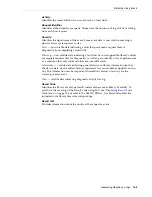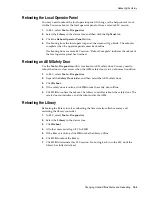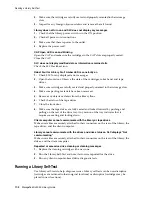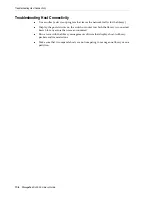
Diagnosing Robotic Issues
Troubleshooting
17-5
■
Pool Address Range
— defines the area used to supply cartridges or empty slots if
a target address does not contain a cartridge or no empty slots are available. The
pool and target address can overlap.
■
Access Order
— determines how the robot performs get operations within the
target address range. There are two options:
–
Sequential
— robot performs a get operation starting with the first location in
the target address range. The robot continues visiting the locations
sequentially through the range until it completes the requested number of
moves.
–
Random
— robot randomly picks a location in the target address range to get a
cartridge. The robot can also visit the same location in the target address range
multiple times to get a cartridge; however, if you specify enough move
requests, the robot is guaranteed to visit all slots. The random access routine
ends after the requested number of moves is complete.
Starting a Diagnostic Move
Before starting a diagnostic move, you must define the move (see
1.
Select
Tools > Diagnostics
. Select the
Library
in the device tree.
2.
Click the
DiagMove
tab, and then the
Manage
tab.
3.
In the Defined Sequences section, select a diagnostic move. Click
Open
.
4.
Select
File > Start Sequence
.
Saving a Diagnostic Move
You can save a defined diagnostic move to a file and use it to restore a move that has
been deleted from the library or copy it to a different library.
1.
Select
Tools > Diagnostics
. Select the
Library
in the device tree.
2.
Click the
DiagMove
tab, and then the
Manage
tab.
3.
In the Defined Sequence section, select a diagnostic move, and then click
Save
at
the top of the SLC screen.
Monitoring and Controlling Open Diagnostic Moves
To start a diagnostic move, see
1.
Select
Tools > Diagnostics
. Select the
Library
in the device tree.
2.
Click the
DiagMove
tab, and then the
Monitor
tab.
Note:
All resources within the target address range are reserved.
However, only the location currently being accessed by the robot for a
get/put operation is unavailable to the host.
Note:
You can run multiple moves simultaneously if the target and
pool address ranges for the moves do not overlap.
Summary of Contents for StorageTek SL3000
Page 1: ...1 StorageTek SL3000 Library Guide E20875 15 December 2018...
Page 16: ...xvi...
Page 50: ...Ordering 1 32 StorageTek SL3000 Library Guide...
Page 62: ...Installation Tools 2 12 StorageTek SL3000 Library Guide...
Page 66: ...Installing Web launched SLC 3 4 StorageTek SL3000 Library Guide...
Page 74: ...Resolving Orphaned Cartridges Caused by Capacity Changes 6 4 StorageTek SL3000 Library Guide...
Page 88: ...Configuring Dual TCP IP 8 8 StorageTek SL3000 Library Guide...
Page 112: ...Stopping a Validation 12 4 StorageTek SL3000 Library Guide...
Page 124: ...Monitoring Library Events 15 6 StorageTek SL3000 Library Guide...
Page 128: ...Rebooting the Library 16 4 StorageTek SL3000 Library Guide...
Page 166: ...Downgrading Firmware D 4 StorageTek SL3000 Library Guide...
Page 183: ...Wall Diagrams Library Addressing Reference E 17 Figure E 14 Base Module Rear Wall...
Page 185: ...Wall Diagrams Library Addressing Reference E 19 Figure E 16 DEM Front Wall...
Page 186: ...Wall Diagrams E 20 StorageTek SL3000 Library Guide Figure E 17 DEM Front Wall continued...
Page 187: ...Wall Diagrams Library Addressing Reference E 21 Figure E 18 DEM Rear Wall...
Page 188: ...Wall Diagrams E 22 StorageTek SL3000 Library Guide Figure E 19 DEM Rear Wall continued...
Page 190: ...Wall Diagrams E 24 StorageTek SL3000 Library Guide Figure E 21 Cartridge Expansion Module Rear...
Page 191: ...Wall Diagrams Library Addressing Reference E 25 Figure E 22 Parking Expansion Module Left...
Page 192: ...Wall Diagrams E 26 StorageTek SL3000 Library Guide Figure E 23 Parking Expansion Module Right...
Page 193: ...Wall Diagrams Library Addressing Reference E 27 Figure E 24 Access Expansion Module Left...
Page 194: ...Wall Diagrams E 28 StorageTek SL3000 Library Guide Figure E 25 Access Expansion Module Right...
Page 202: ...Label Care F 8 StorageTek SL3000 Library Guide...
















































